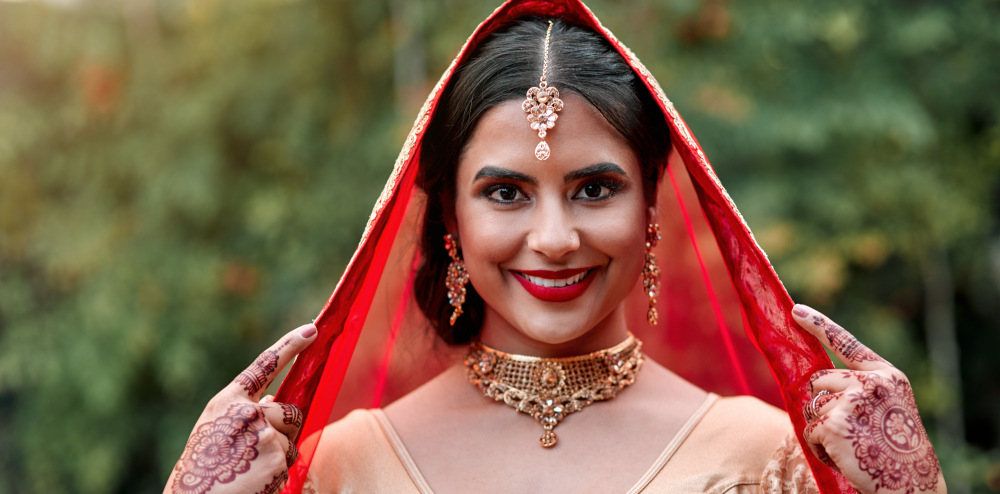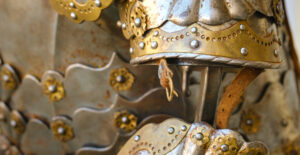
In the age of prenups, swipe-right romances, and registry wishlists dripping in smart appliances, there’s something wildly, almost rebelliously old-school about gold. Not Bitcoin. Not stocks. Not platinum. Just gold, ancient, tangible, weighty gold. Especially when it shows up not in vaults or Cartier windows but in small velvet boxes passed from one family to another, during ceremonies that are part wedding, part negotiation, part ritual theater.
This is the story that keeps happening, from Delhi to Durban, Cairo to Cape Town, and all the way into the digital feeds of modern brides who claim independence, but still post boomerangs of bangles. Because here’s the truth nobody’s tweeting, in many parts of the world, especially across South Africa, Asia, and the Middle East, marriage is still sealed not with a kiss, but with karats. Call it dowry. Call it lobola. Call it a cultural tradition or a problematic relic. Either way, it’s got weight, literal and symbolic.
Across cultures, gold bracelets, necklaces, earrings, and coins have long played a starring role in the economics of love. In traditional Zulu culture, lobola isn’t gold per se, it’s cattle. But in modern adaptations, cattle often give way to cash, and that cash? It sometimes becomes gold, tucked into the bride’s trousseau like a silent promise.
In Indian weddings, the bride often glows brighter than the chandeliers, her body practically draped in the family’s economic history. It’s not just jewelry, it’s insurance, status, and trust, all melted into metal and looped around wrists. This isn’t about fashion. It’s financial fluency. When gold changes hands during marriage ceremonies, it isn’t just a gift, it’s a statement. A negotiation. A security deposit on someone’s daughter.
The bracelet is particularly telling. Unlike a necklace, which may feel ceremonial, or earrings, which can be dainty, a bracelet is worn, lived in, flashed during gestures, and used to signal strength. In many cultures, a bride’s gold bangles are clinked together not just to produce a beautiful sound but to whisper to the room, “She’s taken, and she’s valued.”
In Cape Malay weddings, for example, gifting gold bangles remains customary, even in more Westernised contexts. Often bought in bulk at family-run jewellers in Bo-Kaap, each bracelet becomes a page in a love contract that stretches generations.
In 2025, while gold fluctuates on the global market, it’s still sitting smugly in local jewelry cases, passed on in whispers and wrapped in velvet. Why? Because gold has an emotional ROI. It glows, it stores value, and it doesn’t crash with crypto.
For many families, especially those navigating multi-generational wealth or cultural expectations, the bracelet is the fallback plan. If love fails or life hits hard, a bride with a drawer full of bangles isn’t just well-accessorized, she’s insured. And let’s be real, in some circles, gifting gold isn’t just tradition, it’s a flex. It’s the groom’s family saying, “We’re serious. And we can afford to be.” Gold still seals the deal. In some cultures, if there’s no jewelry exchange, there’s no ceremony.
 Now, here’s the twist. These traditions haven’t faded. They’ve evolved. The Gen Z bride, all about choice and feminism, is just as likely to post her gold gifts to Instagram as she is to choose her own partner. But look closely. In that curated carousel of Mehndi, manicures, and flower showers, there’s always a close-up of the gold.
Now, here’s the twist. These traditions haven’t faded. They’ve evolved. The Gen Z bride, all about choice and feminism, is just as likely to post her gold gifts to Instagram as she is to choose her own partner. But look closely. In that curated carousel of Mehndi, manicures, and flower showers, there’s always a close-up of the gold.
The hashtag may be #modernbride, but the message is as old as time, gold is still the mark of being chosen.
Of course, modern love plays differently. Some couples ditch the whole dowry drama. Others reinvent it. Grooms are gifted gold. Families split the cost. Gendered expectations blur, but gold stays. It’s the common denominator, the legacy you can hold. It’s not about patriarchal hand-me-downs anymore, it’s about what glimmers in the gap between old rules and new love. And yet, behind the glitter, there’s grit.
The commercialization of gold in weddings has, in many regions, turned into economic pressure. Entire families take out loans to ensure the bride “looks the part.” Markets have popped up, fueled by fear and FOMO, where the “minimum” bracelet weight is no longer negotiable. Social status rides on the wrist. Poorer families sometimes suffer under the weight of these expectations, their daughters turned into walking balance sheets. This isn’t romantic, it’s risk in disguise.
But here’s the nuance. Even when the system seems archaic, the gold itself still carries meaning, often beyond what money can quantify. It’s not just a gift. It’s memory. It’s ancestry. It’s the mother who pawned her last bangle to send her daughter to university. It’s the grandmother who wore the same bracelet to her own wedding, half a century ago. Maybe that’s why it endures.
Unlike paper certificates or wedding hashtags, gold doesn’t vanish when the honeymoon ends. It sits in drawers, rests on wrists, sometimes passed on, sometimes pawned, always carrying echoes of promises once made under candlelight or spotlights. So, when you see a bride smile and flash a wrist heavy with bracelets, don’t just see the sparkle. See the centuries. The symbolism. The deal.
Because in many parts of the world, and in many hearts still beating with both hope and history, gold isn’t just jewelry.
It’s a contract.
It’s a currency.
It’s love, sealed.
And if that’s not cinematic, what is?



